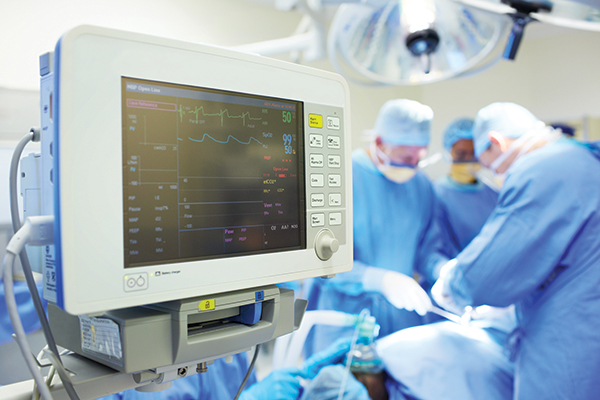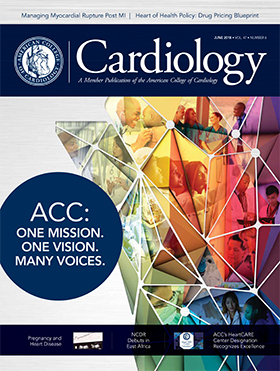Journal Wrap
The hottest research from various peer-reviewed journals — handpicked weekly by the ACC.org Editorial Board led by Kim Eagle, MD, MACC.
Smartphone App May Improve Adherence

A smartphone app that includes reminder alerts and adherence reports may help improve medication adherence in hypertensive patients, according to research published in JAMA Internal Medicine.
Kyle Morawski, MD, MPH, and colleagues enrolled 412 patients with poorly controlled blood pressure (BP) and 210 were randomized to use the Medisafe app, while 202 were randomized to the control arm. Participants were located across the U.S. in a mix of rural, suburban and urban locations. They had a mean age of 52 years and a mean body mass index (BMI) of 35.5; 247 (60 percent) were female and 103 (25 percent) were of black race/ethnicity. Sex, race/ethnicity, BMI and baseline adherence were well balanced between the two arms. Read More >>>
At baseline, mean (SD) medication adherence as measured by the eight-item Morisky Medication Adherence Scale (MMAS-8) was 6.0 (1.8) in the intervention arm and 5.7 (1.8) in the control arm. At the 12-week follow-up, the mean (SD) adherence increased by 0.4 (1.5) in the intervention arm and remained unchanged in the control arm.
The authors, however, did not find that the app helped to lower systolic BP over the study period. At baseline, the mean (SD) systolic BP was 151.4 (9.0) mm Hg and 151.3 (9.4) mm Hg in the intervention and control arms. After 12 weeks of follow-up, the mean (SD) systolic BP decreased by 10.6 (16.0) mm Hg and by 10.1 (15.4) mm Hg in the intervention and control arms. There was no difference in the change in BP between the groups (between-group difference, 0.5 mm Hg; p=0.78). BP control (defined as BP <140/90 mm Hg) at 12 weeks was achieved by 35.8 percent in the intervention arm and 37.9 percent in the control arm (odds ratio, 0.9; p=0.68).
“[W]hile we observed a statistically significant improvement in adherence from the intervention, the magnitude of this change was likely too small to translate into improvements in blood pressure,” the authors write. “A change of two points in the MMAS-8 has been suggested as the minimum detectable difference for antihypertensive medication adherence, which is substantially larger than the mean 0.4-point change that we observed.”
The authors write that more disease-specific customization of smartphone tools may lead to greater benefits for patients with hypertension. Additionally, the app could be linked to clinical care when the patient is able to connect with health care professionals.
Morawaski K, Ghazinouri R, Krumme A, et al. JAMA Intern Med 2018;Apr 16:[Epub ahead of print].
CAC Strong Predictor of 10-Year ASCVD Events
Coronary artery calcium (CAC) is strongly associated with 10-year risk of incident atherosclerotic cardiovascular disease (ASCVD) events, according to a study published in the European Heart Journal.
Matthew J. Budoff, MD, FACC, and colleagues used data from MESA, a prospective multi-ethnic cohort study of 6,814 participants (51 percent women), aged 45-84 years, free of clinical cardiovascular disease at baseline. They evaluated the relationship between CAC and incident ASCVD using Cox regression models adjusted for age, race/ethnicity, sex, education, income, cigarette smoking status, LDL-C, HDL-C, diabetes, lipid-lowering medication, systolic blood pressure, antihypertensive medication, intentional physical exercise and body mass index. Read More >>>
Overall, during the 11.1 years of follow-up, there were 500 hard CVD events (7.4 percent of the total study population). There were also 709 total CVD events (10.5 percent), 321 incident hard coronary heart disease (CHD) (4.7 percent) and 498 total CHD (7.3 percent) events. Hard ASCVD events included 217 myocardial infarctions, 188 strokes, 13 resuscitated cardiac arrests and 82 CHD deaths.
At 10-year follow-up, all participants with CAC >100 had more than a 7.5 percent risk. Additionally, 10-year ASCVD event rates increased steadily across CAC categories regardless of race/ethnicity, age, sex or education. Event rates in the CAC = 0 group ranged from 1.3 percent to 5.6 percent, while for the CAC >300 group rates ranged from 13.1 percent to 25.6 percent.
The researchers found CAC to be independently associated with events, independent of race/ethnicity, sex and age. According to the authors, this makes CAC among the most useful markers for predicting ASCVD risk.
“This is the first study to evaluate true 10-year predictive ability of varying CAC score cutpoints specifically for ASCVD in different ages, genders, and race-ethnicities,” the authors write. “This is also, to our knowledge, the first paper demonstrating that CAC is similarly predictive of ASCVD in patients on or off lipid-lowering therapy.”
Budoff MJ, Young R, Burke G, et al. Eur Heart J 2018;Apr 23:[Epub ahead of print].
Ambulatory BP Monitoring Finds High Rates of Masked Hypertension

The high prevalence of masked hypertension in untreated and treated individuals with normal blood pressure (BP) in the office supports expanding the use of ambulatory BP monitoring (ABPM) in routine clinical practice, according to a research letter published in Circulation.
Recent guidelines propose new values for defining hypertension as office BP ≥130 systolic or ≥80 mm Hg diastolic and the target for drug treatment <130/80 mm Hg. Home BP and 24-hr ABPM are usually used to detect “white-coat” hypertension. In contrast, masked hypertension refers to normal office BP and hypertension in the home or on 24-hour ABPM. Alejandro de la Sierra, MD, PhD, et al., looked to determine the prevalence of masked hypertension and of masked uncontrolled hypertension using 24-hour ABPM in patients with office BP <130/<80 mm Hg (as suggested by the guideline), drawn from the Spanish ABPM Registry. Read More >>>
Values of 125/75, 130/80 and 110/65 mm Hg have been proposed for 24-hour, daytime and nighttime periods, corresponding to the office cutoff of 130/80 mm Hg. Primary care office BP was measured using standardized procedures. The registry had 115,708 patients (45,020 untreated and 70,688 treated for hypertension), of which 90 percent was from primary care centers and 10 percent from hypertension or cardiology clinics.
Based on the ACC/American Heart Association (AHA) hypertension guidelines, masked hypertension and masked uncontrolled hypertension were estimated by considering patients with mean 24-hour ABP ≥125 or ≥75 mm Hg, mean daytime BP ≥130 or ≥80 mm Hg, mean nighttime BP ≥110 or ≥65 mm Hg, or any of these. European Society of Hypertension (ESH) recommendations are 5 mm Hg higher for mean and daytime ABPM and 10 mm Hg higher for nighttime ABPM.
Results showed the mean age (SD) was 59 (14) years and 47 percent were women. Office BP was <130 and <80 mm Hg in 7.7 percent and 8.4 percent of treated patients. Using mean daytime BP, prevalence of masked hypertension was 14 percent and masked uncontrolled hypertension in treated patients was 15 percent with the ESH criteria and 28-30 percent with criteria proposed by the ACC/AHA guidelines. Corresponding figures using mean 24-hour ABPM were 20 percent and 39 percent, respectively.
When compared with patients with both normal office and ambulatory BP, masked hypertension or masked uncontrolled hypertension was associated with a worse cardiovascular risk profile, being older, more frequently male and smokers with higher office systolic BP, and more frequent cardiovascular disease.
“The high prevalence of masked hypertension observed here, in untreated and treated individuals with normal BP in the office, supports a wider use of ABPM in routine clinical practice,” the authors conclude.
de la Sierra A, Banegas JR, Vinyoles E, et al. Circulation 2018;Apr 30:[Epub ahead of print].
BP Drops Not Associated with Neurologic Changes
Peri-interventional blood pressure (BP) drops are not associated with either early neurologic improvement or long-term functional outcome, according to research published in Stroke.
Silvia Schönenberger, MD, et al., performed a post hoc analysis of the single-site SIESTA trial, which randomized 150 acute stroke patients undergoing mechanical thrombectomy to conscious sedation vs. general anesthesia, with strict protocols to target a systolic BP of 140-160 mm Hg. Read More >>>
The SIESTA trial found no significant difference between the conscious sedation and general anesthesia groups for the primary outcome of early neurologic improvement. In this analysis, subjects’ peri-thrombectomy BPs were recorded and divided into four different procedure stages: on presentation to the emergency department, pre-recanalization, post-recanalization and after admission to the neurointensive care unit. Short-term functional outcome was represented by change in National Institutes of Health Stroke Scale (NIHSS) score from admission to 24 hours. Long-term functional outcome was represented by three-month modified Rankin scale (mRS) score.
Data from the 73 general anesthesia and 77 conscious sedation patients enrolled in SIESTA were included in this analysis. No association was observed between early neurologic improvement (change in NIHSS score) and change in systolic BP, change in diastolic BP or change in mean arterial pressure (MAP) from baseline at any procedure stage. These results appeared independent of sedation group (general anesthesia vs. conscious sedation). Similarly, no association was observed between long-term functional outcome (3-month mRS) and change in systolic BP, change in diastolic BP or change in MAP from baseline at any procedure stage. These results also appeared independent of sedation group.
The authors conclude that drops in BP from baseline were neither associated with reduced early neurologic improvement after 24 hours nor with long-term functional outcome, irrespective of the choice of either general anesthesia or conscious sedation. According to the authors, this may be explained by the fact that general anesthesia and conscious sedation were performed according to protocols, which included strict physiological target parameters and were aimed at avoiding extremes.
“It is still possible that sedation management without strict BP target ranges may result in less favorable long-term functional outcomes particularly if collateralization is otherwise compromised,” the authors write. “Hence, BP drops during mechanical thrombectomy should still be avoided.”
Schönenberger S, Uhlman L, Ungerer M, et al. Stroke 2018;May 2:[Epub ahead of print].
Keywords: ACC Publications, Cardiology Magazine, American Heart Association, Anesthesia, General, Antihypertensive Agents, Arterial Pressure, Atherosclerosis, Blood Pressure, Blood Pressure Determination, Blood Pressure Monitoring, Ambulatory, Body Mass Index, Cardiovascular Diseases, Smoking, Conscious Sedation, Coronary Disease, Coronary Vessels, Diabetes Mellitus, Emergency Service, Hospital, Exercise, Follow-Up Studies, Heart Arrest, Hypertension, Lipids, Masked Hypertension, Medication Adherence, Middle Aged, Myocardial Infarction, National Institutes of Health (U.S.), Odds Ratio, Prevalence, Primary Health Care, Prospective Studies, Registries, Risk Factors, Stroke, Systole, Thrombectomy, White Coat Hypertension
< Back to Listings

